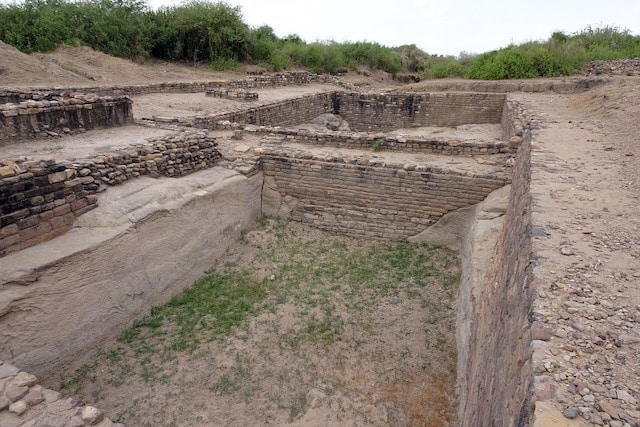10 Hidden Truths About the Indus Valley Civilization That Will Surprise You
When we think of history’s greatest civilizations, names like the Romans, Egyptians, or Vikings instantly come to mind. But there’s one jaw-dropping society that barely gets a mention—the Indus Valley civilization (or Harappans). And that’s a shame, because these guys were centuries ahead of their time.
Flourishing between 3300 BC and 1300 BC, the Harappans pulled off feats that would make even modern engineers pause. Imagine cities with grid-patterned streets and advanced drainage systems—while much of the world was still figuring out mud huts. Their innovations were so ahead of the curve that many ideas vanished for thousands of years before being “reinvented.”
What’s wild? They did all this without flashy emperors or giant pyramids (at least none we’ve found). Instead, they focused on smart, practical solutions—like standardized weights for trade and possibly the world’s first indoor toilets. Yet, for some reason, their story gets buried under tales of gladiators and pharaohs.
10. Ancient Civilizations and the Ingenious Flush Toilets

Toilets have a surprisingly long and fascinating history, filled with both ingenious innovations and some truly unpleasant phases. While modern plumbing is often taken for granted, the idea of a toilet that could flush and dispose of waste efficiently is far from new. Many might assume that this invention is relatively recent, but history tells a different story—one that stretches back thousands of years to an advanced civilization that few would expect.
The Indus Valley Civilization, which flourished over 4,000 years ago, was leagues ahead of its time in terms of sanitation and urban planning. In cities like Mohenjo-daro, residents had access to water drawn from an extensive network of wells—some estimates suggest there were over 700 of them. These weren’t just rudimentary water sources; they supplied entire homes with running water and even facilitated communal bathhouses, making the city one of the earliest examples of organized urban hygiene.
Even more impressive, many homes in Harappa, another major city of the Indus civilization, were equipped with toilets that connected to a public drainage system. This wasn’t just a hole in the ground but an early example of structured sewage management. Waste was carried away through carefully laid-out brick-lined drains—something that wouldn’t become widespread again until the Romans took plumbing to another level nearly two millennia later.
For a long period after the fall of these early sanitation pioneers, many cultures reverted to more primitive methods, relying on chamber pots and less hygienic waste disposal practices. While Thomas Crapper may have popularized aspects of modern plumbing in the 19th century, the fundamental concept of a flush toilet had already been mastered thousands of years before his time.
It’s astonishing to think that an ancient civilization—one that predates most of recorded history—had already developed a system that echoes many modern principles of sanitation. The level of engineering brilliance displayed by the Indus Valley people is yet another reminder of how human ingenuity has always sought ways to improve everyday life, long before the conveniences we now consider standard.
9. They Had Rudimentary Air Conditioning

The Indus Valley Civilization wasn’t just ahead of its time in sanitation—they also found innovative ways to stay cool in the sweltering heat. Long before the invention of modern air conditioning, these ancient engineers devised a natural cooling system that worked remarkably well.
At the heart of this system were wind catchers, towering stone structures designed to harness passing breezes and funnel them into homes. These ingenious designs, still found in parts of Iran today, functioned much like chimneys—but instead of drawing smoke out, they pulled fresh air down through the living spaces. The thick stone walls of the buildings then helped trap the cool air inside, creating a significantly more comfortable indoor climate.
Scientific studies suggest that this technique could lower indoor temperatures by as much as 10 degrees Celsius (18 degrees Fahrenheit). Imagine stepping from a blistering 104°F (40°C) day into a much milder 86°F (30°C) home—still warm, but a world of difference in terms of comfort. This was an incredible feat for an ancient civilization, proving once again that necessity has always been the mother of invention.
What makes this discovery even more fascinating is how eco-friendly it was. Unlike modern air conditioning, which consumes vast amounts of energy, this method relied solely on smart architectural design and the natural elements. The Indus people unknowingly pioneered an early form of sustainable living—something we are only now beginning to appreciate in an age of rising temperatures and energy concerns.
The more we uncover about the Indus Valley Civilization, the clearer it becomes that they were masters of adapting to their environment. From advanced urban planning to ingenious climate control, their innovations continue to leave us in awe thousands of years later.
8. The Mystery of the Indus Script: A Code No One Can Crack

The Indus Valley Civilization remains one of history’s greatest enigmas, not just because of its advanced cities and remarkable infrastructure but also due to a puzzle that has defied scholars for decades—the Indus script. Despite unearthing thousands of inscriptions, researchers are still unable to determine whether these symbols represent a structured language or simply pictorial notations conveying broad ideas.
Unlike the scripts of ancient Egypt or Mesopotamia, which scholars eventually decoded, the Indus script remains a riddle. The inscriptions are often remarkably short, usually consisting of no more than four or five characters, offering little context for linguists to work with. Without a decipherable Rosetta Stone equivalent, every attempted translation remains speculative at best.
What makes things even more complicated is the intense debate surrounding its origins. Some researchers believe the script might have evolved into a modern language, while others argue that it never functioned as a true linguistic system. The topic is so controversial that attempts to question its lineage have, at times, resulted in hostile backlash—some scholars have even faced threats for suggesting that the script may not be linked to any living language today.
Over the years, experts have put forth numerous theories. Some propose that the symbols were used more like seals or trade marks rather than a spoken or written language. Others believe it might have been a proto-language, representing early forms of communication rather than a fully developed linguistic system. However, without longer inscriptions or a bilingual reference, cracking the Indus script remains an unsolved puzzle.
For now, the script stands as a silent relic of an ancient world, teasing us with the possibility of unlocking lost knowledge—if only we could read what it says.
7. The Mysterious Unicorns of the Indus Valley Civilization

Throughout history, different cultures have been fascinated by mythical creatures, weaving them into their art, folklore, and beliefs. The Greeks had the Minotaur, the Chinese revered dragons, and Ireland is home to leprechauns and fairies. But if we turn our attention to the ancient Indus Valley Civilization, a surprising symbol emerges over and over again: the unicorn.
Archaeologists have uncovered numerous seals and inscriptions from the Indus Valley, many of which prominently feature a one-horned creature. In fact, among all the symbols and animals depicted, the unicorn appears most frequently. But what does this mean? Why was this particular creature so significant to the Indus people?
One theory suggests that these unicorn-like depictions might have been inspired by the nilgai, an antelope species native to South Asia, also called the “blue cow.” However, real nilgais have two horns, whereas the ones carved into these ancient seals have just one. This has led scholars to believe that the Indus people might have either stylized the animal into a mythical version or, like other civilizations, created their own legendary beast.
The real mystery, however, lies in the purpose behind these unicorn depictions. Were they symbolic of power, spirituality, or prosperity? Many of these seals also contain images of trees and plants, which could indicate a connection to agriculture, fertility, or nature’s cycles. Unfortunately, the Indus script remains undeciphered, leaving us with more questions than answers.
Until we unlock the secrets of their language, the unicorn of the Indus Valley will remain one of history’s most fascinating enigmas—a reminder that even thousands of years ago, people were drawn to the extraordinary, the magical, and the unknown.
6. They Were the First to Invent Buttons

Buttons are everywhere—on jackets, jeans, and shirts—yet we rarely stop to think about where they came from. Despite their small size, buttons have a fascinating history that dates back thousands of years, and it all started in the Indus Valley Civilization around 2000 BC.
The earliest buttons weren’t for fastening clothes. Instead, they were decorative pieces made from curved shells, often found adorning the garments of the wealthy or socially important. In a time before luxury brands, wearing these delicate ornaments was a way of signaling prestige and status. Imagine an ancient version of high-end fashion accessories—if you had buttons, you were making a statement.
These early buttons were carefully drilled and attached using thread, showing an impressive level of craftsmanship for the time. They weren’t placed randomly either—many were arranged in geometric patterns, much like modern rhinestones or sequins, creating eye-catching designs that showcased artistry as much as affluence.
Surprisingly, it took centuries before buttons evolved into their modern role as functional fasteners. But their origins in the Indus Valley remind us that even the simplest objects have deep and fascinating histories. Next time you button up your coat, remember—you’re carrying forward a tradition that began over 4,000 years ago!
5. The Ancient Dice That Started Your Board Game Addiction

If you’ve ever rolled a six-sided die during a heated game night, you might owe that tiny cube of fate to the Indus Valley civilization. Yep, those ancient folks might’ve been the original dice-obsessed gamers—long before Yahtzee or Dungeons & Dragons took over our living rooms.
Archaeologists digging up Harappa (one of the major cities of the Indus Valley) stumbled upon a carefully crafted die that looks shockingly familiar. It had dots from one to six, just like modern dice, but with a quirky twist: the numbers weren’t arranged the way we know them today. Instead of opposite sides adding up to seven (like 6 vs. 1), the Harappan die had 1 opposite 2, 3 opposite 4, and so on. Weird, right?
But here’s the kicker—they didn’t just make one. Dozens of dice were found in Mohenjo-daro, another Indus city, and they were often used in pairs, cut to identical sizes. That’s not some accident—it means these guys put serious thought into their gaming tools. Were they gambling? Testing luck? We might never know, but one thing’s clear: the love of rolling dice is way older than we thought.
4. The World’s Oldest Public Pool: A 5,000-Year-Old Marvel

Swimming is one of humanity’s oldest pastimes, and today, the US alone boasts over 300,000 public pools. But long before modern waterparks and Olympic-sized pools, ancient civilizations were already perfecting the art of communal bathing. One of the earliest examples? The Great Bath of Mohenjo-daro, a stunning architectural feat from the Indus Valley Civilization that dates back an astonishing 5,000 years.
This ancient pool wasn’t massive by today’s standards, measuring just 39 feet by 23 feet and reaching a depth of under 8 feet. But its construction was nothing short of genius. The builders used meticulously arranged bricks and a sophisticated waterproofing technique—an achievement that still amazes archaeologists. Despite centuries of exposure, this bath remains remarkably well preserved, offering us a rare glimpse into the advanced engineering of the time.
What was it used for? That remains a mystery. Some believe it served as a place for ritual purification, possibly linked to religious ceremonies. Others speculate it was a gathering spot for elite members of society, or even a residential complex for priests who oversaw sacred rites. While no one knows for sure, one thing is certain—this wasn’t just a simple swimming hole; it was a centerpiece of an advanced and enigmatic civilization.
Today, the Great Bath is a UNESCO World Heritage Site, standing as a testament to the ingenuity of early urban societies. It’s incredible to think that while our modern pools come with chlorine, diving boards, and lifeguards, the essence of communal bathing has remained unchanged for thousands of years. Whether for ritual or relaxation, water has always drawn us together—a tradition as ancient as civilization itself.
3. Ancient Dentistry: The Indus Valley’s Unexpected Innovation

Nobody enjoys a trip to the dentist. It’s an uncomfortable, sometimes nerve-wracking experience, even when you know it’s necessary. But now, imagine sitting in the chair of one of the first dentists in history—a craftsman from the Indus Valley civilization thousands of years ago—armed not with modern tools but with a primitive bow drill.
Sounds terrifying? It happened.
Archaeologists have uncovered evidence that the Indus Valley civilization, which thrived over 7,500 to 9,000 years ago, had developed a form of early dental surgery. This wasn’t some crude or accidental practice; it was a deliberate, precise procedure. The same tools they used to drill tiny holes into beads and ornaments were also repurposed to drill into human teeth.
The discovery came from eleven teeth belonging to nine individuals, all showing signs of having been drilled while the person was still alive. The wear patterns suggest that these weren’t post-mortem alterations—they were real, functioning teeth that continued to be used after the procedure. Whether it was meant to remove cavities, relieve pain, or serve some unknown purpose, we can only speculate. And as for anesthesia? There’s no evidence they had anything to numb the pain.
The idea of ancient humans enduring such a treatment without painkillers is almost as shocking as the fact that they were performing it in the first place. Yet, it speaks to the advanced ingenuity of this long-lost civilization. Their expertise wasn’t just about building cities and crafting exquisite jewelry—they also ventured into early medical sciences in ways that still leave modern researchers in awe.
2. The Indus Valley Civilization Vanished—And We Still Don’t Know Why

Imagine a thriving ancient society—advanced cities, clever trade networks, even early indoor plumbing—then poof, gone without a trace. No dramatic fall, no epic battles carved into stone. Just… silence. That’s the eerie mystery of the Indus Valley Civilization, one of history’s greatest unsolved puzzles.
We didn’t even know about these people until 1920, when ruins of Harappa were first dug up. They flourished for 2,000 years (3300–1300 BCE), then vanished. No scrolls, no “we’re doomed” carvings—just empty streets and crumbling bricks. So what wiped them out?
Theories? Plenty. Some say overcrowding—houses stacked atop houses like a desperate game of Jenga. Others blame collapsing trade with Mesopotamia, where chaos was brewing. But the spookiest idea? Nature turned against them. The mighty Indus River, their lifeline for water and commerce, may have shifted course, drowning cities in floods. Nearby rivers could’ve dried up, triggering famine and disease. Starving, sick, and trapped, the people likely fled—or didn’t survive.
War? Maybe. Climate change? Very possible. But the truth? Buried deep, leaving us with a ghost story written in dust. One thing’s clear: even the mightiest civilizations aren’t immortal. And that’s a humbling thought.
1. They Had No Weapons or Army: A Civilization Unlike Any Other

The Indus Valley Civilization remains one of the greatest mysteries of ancient history. Flourishing around 2500 BCE in what is now Pakistan and northwest India, this advanced society thrived for centuries—yet, intriguingly, it appears to have had no military force to defend itself. This peculiarity raises the question: How did they maintain stability without an army?
Archaeological digs across sites like Mohenjo-Daro and Harappa have unearthed no swords, spears, or shields—objects typically found in ancient civilizations. Unlike the war-driven cultures of Mesopotamia and Egypt, the Indus people seem to have avoided large-scale conflict altogether. There are no fortresses or battle scars on their ruins, and while some figurines depict unusual creatures—such as a goat-horned figure with a tiger’s body—none suggest organized warfare.
Even more fascinating is the apparent absence of kings or emperors. Unlike most early civilizations where power was centralized, the Indus society appears to have been remarkably egalitarian. There are no grand palaces, no towering statues of rulers, and no signs of extreme wealth disparity. Homes, whether belonging to merchants or laborers, were strikingly uniform in size and layout, suggesting a communal way of life where resources were shared fairly.
Could this be history’s closest example of a true utopia? While we may never know exactly how this society functioned without a ruling elite or a military, its peaceful and structured existence challenges modern assumptions about governance and power. And yet, despite its brilliance, the civilization mysteriously vanished around 1900 BCE. Was it climate change? A slow economic collapse? Theories abound, but one thing is certain—the Indus Valley people built a world that defied expectations, leaving behind a legacy that continues to astonish historians and archaeologists alike.
























